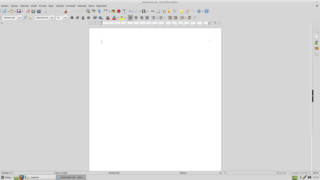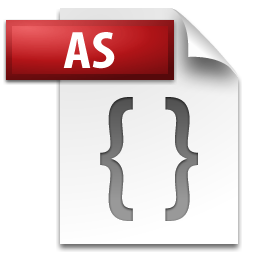In computing, a segmentation fault or access violation is a fault, or failure condition, raised by hardware with memory protection, notifying an operating system (OS) the software has attempted to access a restricted area of memory. On standard x86 computers, this is a form of general protection fault. The operating system kernel will, in response, usually perform some corrective action, generally passing the fault on to the offending process by sending the process a signal. Processes can in some cases install a custom signal handler, allowing them to recover on their own, but otherwise the OS default signal handler is used, generally causing abnormal termination of the process, and sometimes a core dump.
In computer programming, lazy initialization is the tactic of delaying the creation of an object, the calculation of a value, or some other expensive process until the first time it is needed. It is a kind of lazy evaluation that refers specifically to the instantiation of objects or other resources.

In computer programming, the flyweight software design pattern refers to an object that minimizes memory usage by sharing some of its data with other similar objects. The flyweight pattern is one of twenty-three well-known GoF design patterns. These patterns promote flexible object-oriented software design, which is easier to implement, change, test, and reuse.
In software design and engineering, the observer pattern is a software design pattern in which an object, named the subject, maintains a list of its dependents, called observers, and notifies them automatically of any state changes, usually by calling one of their methods.
In object-oriented (OO) and functional programming, an immutable object is an object whose state cannot be modified after it is created. This is in contrast to a mutable object, which can be modified after it is created. In some cases, an object is considered immutable even if some internally used attributes change, but the object's state appears unchanging from an external point of view. For example, an object that uses memoization to cache the results of expensive computations could still be considered an immutable object.
QuickDraw was the 2D graphics library and associated application programming interface (API) which is a core part of classic Mac OS. It was initially written by Bill Atkinson and Andy Hertzfeld. QuickDraw still existed as part of the libraries of macOS, but had been largely superseded by the more modern Quartz graphics system. In Mac OS X Tiger, QuickDraw has been officially deprecated. In Mac OS X Leopard applications using QuickDraw cannot make use of the added 64-bit support. In OS X Mountain Lion, QuickDraw header support was removed from the operating system. Applications using QuickDraw still ran under OS X Mountain Lion to macOS High Sierra; however, the current versions of Xcode and the macOS SDK do not contain the header files to compile such programmes.

ActionScript is an object-oriented programming language originally developed by Macromedia Inc.. It is influenced by HyperTalk, the scripting language for HyperCard. It is now an implementation of ECMAScript, though it originally arose as a sibling, both being influenced by HyperTalk. ActionScript code is usually converted to byte-code format by a compiler.
QuickDraw GX was a replacement for the QuickDraw (QD) 2D graphics engine and Printing Manager inside the classic Mac OS. Its underlying drawing platform was an object oriented, resolution-independent, retained mode system, making it much easier for programmers to perform common tasks. Additionally, GX added various curve-drawing commands that had been lacking from QD, as well as introducing TrueType as its basic font system.
In compiler construction, name mangling is a technique used to solve various problems caused by the need to resolve unique names for programming entities in many modern programming languages.
In computer science, a mutator method is a method used to control changes to a variable. They are also widely known as setter methods. Often a setter is accompanied by a getter, which returns the value of the private member variable. They are also known collectively as accessors.
Core Foundation is a C application programming interface (API) written by Apple for its operating systems, and is a mix of low-level routines and wrapper functions. Most Core Foundation routines follow a certain naming convention that deal with opaque objects, for example CFDictionaryRef for functions whose names begin with CFDictionary, and these objects are often reference counted (manually) through CFRetain and CFRelease. Internally, Core Foundation forms the base of the types in the Objective-C standard library and the Carbon API.
In computer programming, the term hooking covers a range of techniques used to alter or augment the behaviour of an operating system, of applications, or of other software components by intercepting function calls or messages or events passed between software components. Code that handles such intercepted function calls, events or messages is called a hook.

The syntax of JavaScript is the set of rules that define a correctly structured JavaScript program.
C++11 is a version of the ISO/IEC 14882 standard for the C++ programming language. C++11 replaced the prior version of the C++ standard, called C++03, and was later replaced by C++14. The name follows the tradition of naming language versions by the publication year of the specification, though it was formerly named C++0x because it was expected to be published before 2010.
A property, in some object-oriented programming languages, is a special sort of class member, intermediate in functionality between a field and a method. The syntax for reading and writing of properties is like for fields, but property reads and writes are (usually) translated to 'getter' and 'setter' method calls. The field-like syntax is easier to read and write than many method calls, yet the interposition of method calls "under the hood" allows for data validation, active updating, or implementation of what may be called "read-only fields".
In software engineering, a fluent interface is an object-oriented API whose design relies extensively on method chaining. Its goal is to increase code legibility by creating a domain-specific language (DSL). The term was coined in 2005 by Eric Evans and Martin Fowler.
In object-oriented computer programming, a null object is an object with no referenced value or with defined neutral (null) behavior. The null object design pattern, which describes the uses of such objects and their behavior, was first published as "Void Value" and later in the Pattern Languages of Program Design book series as "Null Object".
Clutter is a discontinued GObject-based graphics library for creating hardware-accelerated user interfaces. Clutter is an OpenGL-based 'interactive canvas' library and does not contain any graphical control elements. It relies upon OpenGL (1.4+) or OpenGL ES for rendering,. It also supports media playback using GStreamer and 2D graphics rendering using Cairo.
This article describes the syntax of the C# programming language. The features described are compatible with .NET Framework and Mono.
A vertex buffer object (VBO) is an OpenGL feature that provides methods for uploading vertex data to the video device for non-immediate-mode rendering. VBOs offer substantial performance gains over immediate mode rendering primarily because the data reside in video device memory rather than system memory and so it can be rendered directly by the video device. These are equivalent to vertex buffers in Direct3D.

